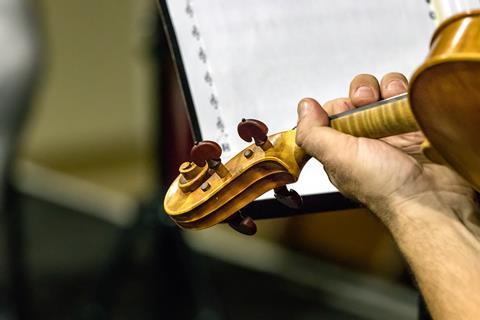Bow maker Bernd Müsing believes that widening violin and viola necks could help young players, especially teenage boys, who find that there is no longer enough space between the strings for their growing fingertips

Discover more Featured Stories like this in The Strad Playing Hub
Read more premium content for subscribers here
Can you imagine a world where all clothes and shoes are made in one size only? Where all bicycles have the same frame size? A world in which one kind of shoulder rest and one kind of chin rest must do for all violin and viola players, ignoring their different shapes and builds?
I began learning the violin at the age of twelve, as my second instrument after the guitar. I was already quite tall, so I started out on a full-sized violin. My teacher was very happy with the rapid progress that I made, and I fell in love with the instrument. After a few years, my teacher proposed that I participate in the Jugend Musiziert (‘Youth Makes Music’) competition.
One of the pieces I prepared was Telemann’s First Solo Sonata. The second movement has plenty of triple- and quadruple-stops in it, and that’s exactly where my potential career as a violinist ended. I messed up those chords so badly that the jury told me to skip the repetition. They were absolutely right, but it still hurt.
I knew exactly how to play those chords, and only one year earlier they had been no problem at all, but now they had become impossible. It took me another 40 years to figure out what had happened: I had simply grown up. All my bones had grown, including those at the very ends of my fingertips, and my fingers just did not fit in between the strings any more.
But I was lucky. My teacher steered me away from repertoire like Bach and Telemann, though I don’t think she had figured out what the problem was. She also invited me to play in the orchestra she led, so I did not quit playing.
So all’s well that ends well? I don’t think so. Look at the violin and viola sections in a school or youth orchestra: the majority of the players will be girls. It’s my belief that we are losing most of the teenage boys who learn the violin simply because their fingertips no longer fit between the strings, so they give up.
I had grown up, and my fingers just did not fit between the strings any more
The cause of this problem only dawned on me two years ago, and I decided to tackle it at once. I looked through the violins in our shop and found one with a somewhat wider neck, on which I put a new fingerboard: 25mm instead of the standard 23mm. This meant the string spacing, from the G to the E string, was 19mm instead of 16.5mm – a significant 0.8mm extra between each string. The first time I played this violin, tackling Telemann and some Bach, it was a very emotional experience.
Since then, I have found out that this issue is not entirely uncommon. I have met other male players who have had their fingerboards fixed (the string spacing by the bridge is unaffected, by the way), and a few makers who are aware of the problem, but the majority of teachers, dealers and makers, as well as students and their parents, are oblivious to the matter.
But how did we end up in this situation? Back in Stradivari’s times, fingerboards widths were not standardised, and made to individual players’ needs. Many measured 25–27mm at the nut, much wider than today’s 23–23.5mm. Sure, strings were thicker, but people were smaller.
When a fingerboard is replaced, the sides are scraped and sanded, together with the neck, to make everything flush. Every time this process is undertaken, we lose around a tenth of a millimetre on both sides. Repeat this several times, and you end up with necks as narrow as they are today.
So what must be done? Teachers, makers and factories need to understand the issue and take action. Players like me, with wide fingertips, need to know there are solutions. Student instruments with proper string spacing must be made and distributed. We can’t afford to keep losing boys who learn violin and viola, and everyone in our industry needs to help.
Read: Products February 2023: Müsing carbon fibre double bass bow
Read: Opinion: The benefits of rest for students
Discover more Featured Stories like this in The Strad Playing Hub
Read more premium content for subscribers here
The number one source for playing and teaching books, guides, CDs, calendars and back issues of the magazine.
In The Best of Technique you’ll discover the top playing tips of the world’s leading string players and teachers. It’s packed full of exercises for students, plus examples from the standard repertoire to show you how to integrate the technique into your playing.
The Strad’s Masterclass series brings together the finest string players with some of the greatest string works ever written. Always one of our most popular sections, Masterclass has been an invaluable aid to aspiring soloists, chamber musicians and string teachers since the 1990s.
American collector David L. Fulton amassed one of the 20th century’s finest collections of stringed instruments. This year’s calendar pays tribute to some of these priceless treasures, including Yehudi Menuhin’s celebrated ‘Lord Wilton’ Guarneri, the Carlo Bergonzi once played by Fritz Kreisler, and four instruments by Antonio Stradivari.






































1 Readers' comment